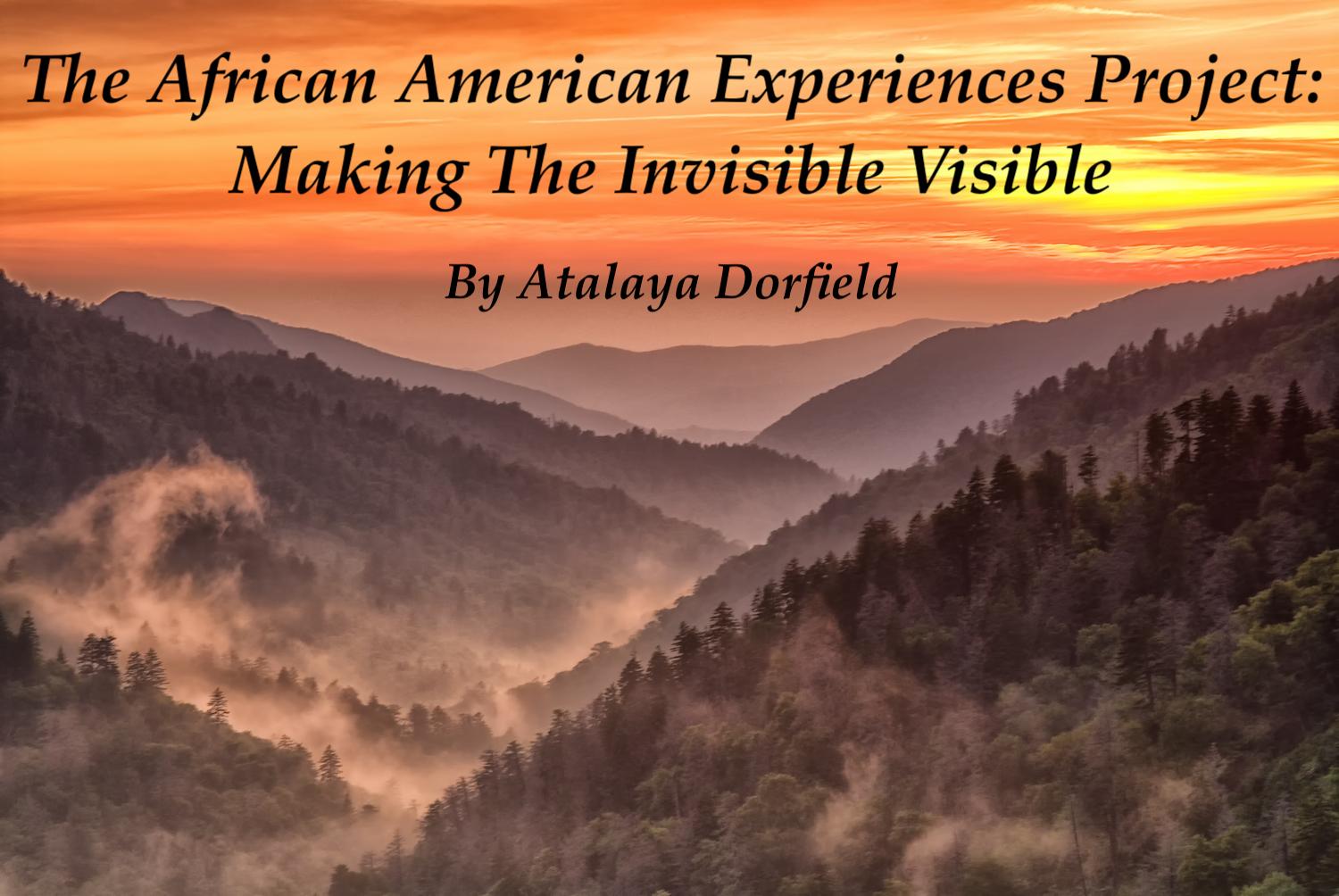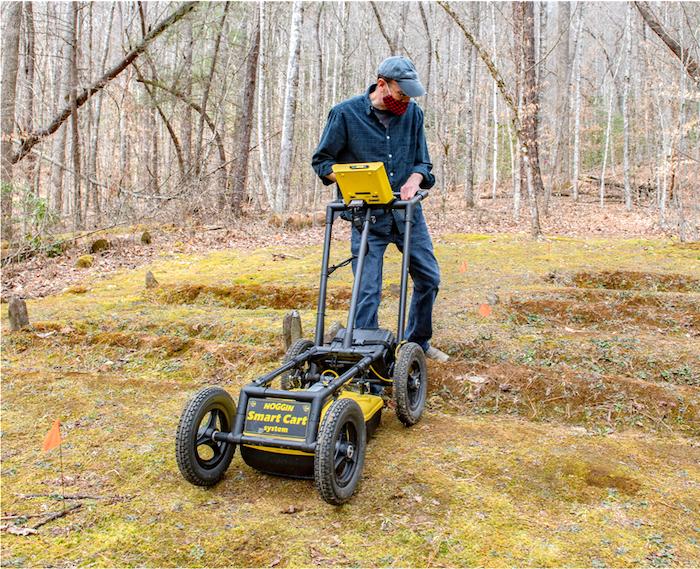
Photo of Morton Overlook by Harold Jerrill
Editor's note: In 2018, Great Smoky Mountains National Park began a concentrated effort to tell the stories of African Americans who have lived and worked in the Smokies over the past several centuries. Born out of that focus, the African American Experiences Project aims to collect the stories and history of Black people in the Smokies and to educate the public about their historical presence and contributions dating back to the 1540s. In the following article, Atalaya Dorfield recounts her hike into the park to learn about research into an unmarked African cemetery.
A year-and-a-half ago, if you would have told me that today I would be working with the National Park Service, my response would have been, “What is the National Park Service?”
I never would have imagined that I would be writing this column for Black History Month or that, in June of 2021, I would be hiking up a steep, untrailed mountain with tall grass brushing my elbows and rain clouds rolling in above me.
Ahead of me was Blair Tormey, a geologist and research scientist from Western Carolina University, pushing away low-hanging tree limbs as we trekked up the mountain. Antoine Fletcher, science communicator and head of the African American Experiences in the Smokies Project, took a beat to look over at me every couple of minutes, laughing as I awkwardly attempted to make it up the mountain without tripping over a tree root.

Antoine Fletcher, GSMNP science communicator and head of the African American Experiences in the Smokies Project, coordinates efforts at Enloe Enslaved Cemetery/NPS
That day a seasonal ranger guided us up to the flat mountaintop where the unmarked Ravensford African Cemetery is located. Surrounded by twigs and leaves, three stones were firmly set into the earth serving as grave markers.
We had so many questions: Who exactly was buried up here? Why did they choose this spot for the burials? How did people get the bodies up the mountain? Did they use horses to transport the supplies they needed?
As the research assistant for the African American Experiences Project at Great Smoky Mountains National Park through my internship with Greening Youth Foundation, I have learned that the 9,000 years of human history that lives within these mountains will always lead to more questions of who? why? and how?
To answer some of those questions, Tormey can use ground penetrating radar (GPR), helping us learn more about the six known Black cemeteries located in the park. Prior to our journey up to the Ravensford Cemetery that day, he demonstrated how he uses GPR at the Enloe Enslaved Cemetery near Mingus Mill.
GPR sends radar waves eight to 11 feet into the ground, which allowed Tormey to identify eight burials dating back to the 1860s. To help discover new burials, he works with Paul Martin, an archaeologist who uses cadaver dogs that are trained to sniff out burials that can date back as far as 1,400 years.
The existence of enslaved cemeteries in the park is important because they tell us that Black people have historically lived in the region and that slavery was indeed present in the Smokies.
Free Black people like Cooper Clark and his family also resided in the Smokies in the 1850s. The railroad and logging industries later led African Americans to migrate to the Smokies from the Deep South for job opportunities. Some of their descendants still live in the region.

Geologist Blair Tormey uses ground penetrating radar to discover graves at Enloe Enslaved Cemetery in GSMNP/NPS
African Americans have a rich history in the Smokies that is just as deeply rooted as the stories of white settlers. However, the stories of Black people are often left out of the narratives that are popularly told about these mountains.
In December of 2021 I had the pleasure of conducting an oral history with Ann Miller Woodford, an artist, writer, and historian from Cherokee County. She aims to “make the invisible visible” by sharing the untold stories of African Americans in far western North Carolina with the world.
“We grew up in a community that my grandfather [William Cleveland Miller] founded,” Miller Woodford said. “He came up from Georgia in 1912 after the ethnic cleansing that took place in Cumming, Georgia. The area was called Valley Town back in those days. Grandpa purchased the property and built the first house in the community that they called Happy Top… because it made everybody happy. [It] was just the Black community when I grew up, but the white community has accepted it all the way down to the edge of the town of Andrews because they love the name. Everybody calls it Happy Top now.”
Other African Americans like Miller Woodford have a familial history in the Smokies. However, she did not grow up visiting Great Smoky Mountains National Park because it would have required her and her family to travel through “sundown towns.”
While many in the African American community have avoided recreating in the wilderness out of concern for their safety, the number of African Americans recreating and working in the outdoors is progressively growing.
Last year Fletcher conducted an oral history with Daniel White, The Blackalachian, who thru hiked the Appalachian Trail in 2017. Even though the AT was his first experience hiking, he found purpose in it, and has built a life and career around it.
“What I have stumbled into with this hiking is my calling,” White said. “I can feel the energy of African Americans who were here before me. I want to search for that history, and I want to go back. I can feel the connection. This outdoor stuff comes too easy. It’s what I was meant to do.”
We hope that by sharing these stories we will inspire more African Americans like The Blackalachian to embrace their history in the outdoors and their right to enjoy the Smokies, as well as journalists like me who somehow stumbled upon the park out of a desire to learn the who, why, and how.
Atalaya Dorfield is from Charlotte and currently resides in Asheville. After completing her bachelor’s degree in English with a minor in Art History at the University of North Carolina at Charlotte, she earned a Master’s degree in Black British Writing at Goldsmiths, University of London. Learn more about the African American Experiences Project at https://www.nps.gov/grsm/learn/historyculture/african-american-experienc....

Add comment